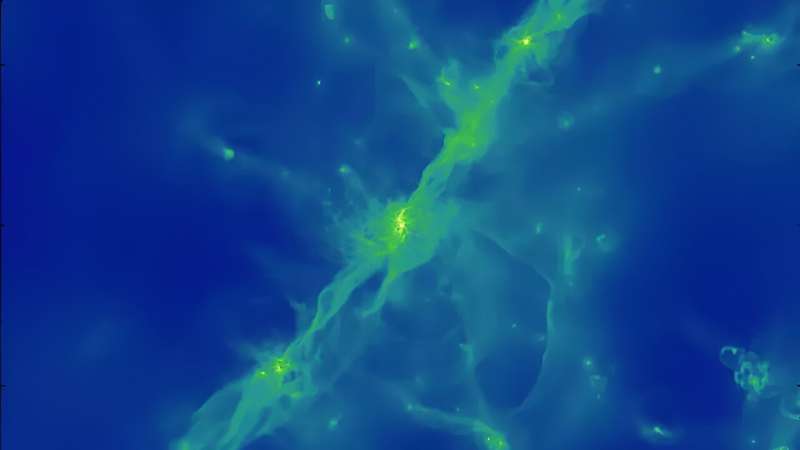This article has been reviewed according to Science X's editorial process and policies. Editors have highlighted the following attributes while ensuring the content's credibility:
fact-checked
peer-reviewed publication
trusted source
proofread
High-resolution simulations provide new insights into how galaxies are formed

Astronomers can use supercomputers to simulate the formation of galaxies from the Big Bang 13.8 billion years ago to the present day. But there are a number of sources of error. An international research team, led by researchers in Lund, has spent a hundred million computer hours over eight years trying to correct these.
The last decade has seen major advances in computer simulations that can realistically calculate how galaxies form. These cosmological simulations are crucial to our understanding of where galaxies, stars and planets come from. However, the predictions from such models are affected by limitations in the resolution of the simulations, as well as assumptions about a number of factors, such as how stars live and die and the evolution of the interstellar medium.
To minimize the sources of error and produce more accurate simulations, 160 researchers from 60 higher education institutions—led by Santi Roca-Fàbrega at Lund University, Ji-hoon Kim at Seoul National University and Joel R. Primack at the University of California—have collaborated and now present the results of the largest comparison of simulations done ever.
"To make progress towards a theory of galaxy formation, it is crucial to compare results and codes from different simulations. We have now done this by bringing together competing code groups behind the world's best galaxy simulators in a kind of supercomparison," says Santi Roca-Fàbrega, a researcher in astrophysics.
Three papers from this collaboration, known as the CosmoRun simulations, have been accepted for publication in The Astrophysical Journal; all are available on the arXiv preprint server. In these, the researchers have analyzed the formation of a galaxy with the same mass as the Milky Way. The simulation is based on the same astrophysical assumptions about the ultraviolet background radiation produced by the first stars in the universe, the gas cooling and heating, and the process of star formation.
The new results allow the researchers to conclude that disk galaxies like the Milky Way formed very early in the history of the universe, in line with observations from the James Webb Telescope. They have also found a way to make the number of satellite galaxies—galaxies orbiting larger galaxies—consistent with observations finally solving a problem well known in the community and known as "the missing satellites problem."
In addition, the team has revealed how the gas surrounding galaxies is the key to realistic simulations, rather than the number and distribution of stars, which had previously been the standard.
"The work has been going on for the past eight years and has entailed running hundreds of simulations and using a hundred million hours of supercomputing facilities," says Santi Roca-Fàbrega.
Now the journey continues to further refine the simulations of galaxy formation. With each technological achievement, Santi Roca-Fàbrega and his colleagues hope to add new pieces to the dizzying puzzle of the birth and evolution of the universe and galaxies.
"This is the start of more reliable simulations of galaxy formation, which in turn will help us to better understand our home galaxy, the Milky Way," says Santi Roca-Fàbrega.
More information: Santi Roca-Fàbrega et al, The AGORA High-resolution Galaxy Simulations Comparison Project IV: Halo and Galaxy Mass Assembly in a Cosmological Zoom-in Simulation at z ≤ 2, arXiv (2024). DOI: 10.48550/arxiv.2402.06202
Minyong Jung et al, The AGORA High-resolution Galaxy Simulations Comparison Project. V: Satellite Galaxy Populations In A Cosmological Zoom-in Simulation of A Milky Way-mass Halo, arXiv (2024). DOI: 10.48550/arxiv.2402.05392
Clayton Strawn et al, The AGORA High-resolution Galaxy Simulations Comparison Project. VI. Similarities and Differences in the Circumgalactic Medium, The Astrophysical Journal (2024). DOI: 10.3847/1538-4357/ad12cb. On arXiv: DOI: 10.48550/arxiv.2402.05246
Journal information: Astrophysical Journal , arXiv
Provided by Lund University





















